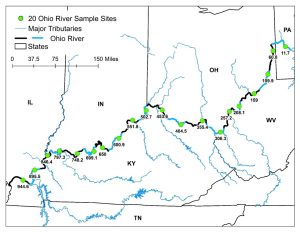Posted on April 11, 2023 by David Flannery
Even as my ACOEL colleagues address PFAS regulatory updates that have been occurring in recent months and will continue to unfold in the future, I am mindful of the significant efforts that are being undertaken to characterize the presence of PFAS compounds in the environment.
One of the more significant of these efforts is the survey of the Ohio River that is being conducted by the Ohio River Valley Water Sanitation Commission (ORSANCO), an interstate compact of which I am a Commissioner.
In 2022, ORSANCO completed the initial phase of an extensive project to characterize the ambient levels of PFAS compounds in the 981-mile-long Ohio River as it extends from Pittsburgh, Pennsylvania to Cairo, Illinois where it empties in the Mississippi River.
In conducting the study, ORSANCO partnered with USEPA to provide the lab that analyzed river samples taken at 20 locations. The sample locations were selected to characterize ambient river conditions and to avoid sampling in either discharge mixing zones or water supply intakes and are shown in the accompanying map. ORSANCO’s report on this phase of the study was published on June 17, 2022 and is available here: https://www.orsanco.org/wp-content/uploads/2022/06/Report-Ohio-River-PFAS-ORSANCO_2022-R10.pdf.
The following are highlights from the first round of sampling taken in the summer of 2021:
- Every site had detections of multiple PFAS compounds.
- Twelve of twenty-eight PFAS compounds analyzed were detected; nine were detected frequently.
- Five of twenty-eight PFAS compounds were detected above the laboratory Limit of Quantification.
- PFOA and HFPO-DA were detected above the Limit of Quantification most frequently.
- HFPO-DA had the highest concentration at 32.2 ng/L.
- PFOA was detected at nineteen sites with a range from 4.88 ng/L to 12.90 ng/L.
- HFPO-DA (GenX) was detected at nine sites with a range from 5.63 ng/L to 32.20 ng/L.
- PFOS was detected below the LOQ at every site.
- PFBA was detected at one site at 5.31 ng/L.
- PFBS was detected at three sites with a range from 5.01 ng/L to 6.05 ng/L.
- PFPeA was detected at five sites with a range from 5.76 ng/L to 26.60 ng/L.
The following are the highlights from the second round of sampling taken in the fall of 2021:
- Every site had detections of one or more PFAS compounds.
- Nine of twenty-eight PFAS compounds were detected; eight were detected frequently.
- Six of twenty-eight PFAS compounds were detected above the Level of Quantification.
- PFOA and PFBA were detected above the Limit of Quantification most frequently, followed by HFPO-DA.
- 6:2FTS had the highest concentration at 28.2 ng/L, followed by HFPO-DA at 12.0 ng/L.
- PFOS was detected at one site at 7.73 ng/L.
- PFOA was detected at seven sites with a range from 5.00 ng/L to 6.82 ng/L.
- HFPO-DA (GenX) was detected at four sites with a range from 5.43 ng/L to 12.0 ng/L.
- PFBA was detected at eight sites with a range from 5.53 ng/L to 10.30 ng/L.
ORSANCO plans to repeat this sampling every 5 years to monitor any change that may occur and will begin in 2023 to collect fish tissue samples to be analyzed for PFAS.
These results make it clear that PFAS is everywhere – at least in the Ohio River – and is found in concentrations that are orders of magnitude higher than EPA’s interim health advisories for PFOA and PFOS published in the June 2022. 87 Fed. Reg. 36848, June 21, 2022. https://www.govinfo.gov/content/pkg/FR-2022-06-21/pdf/2022-13158.pdf

